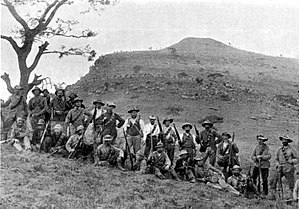South Africa 1902
| Second Boer War | |||||||||
|---|---|---|---|---|---|---|---|---|---|
| Part of the Boer Wars | |||||||||
 Boer militiamen at Spionkop |
|||||||||
|
|||||||||
| Belligerents | |||||||||
|
|||||||||
| Commanders and leaders | |||||||||
|
|
|
||||||||
| Strength | |||||||||
|
British Regulars: 347,000 Colonial Forces: 103,000–153,000 Black South African Auxillaries: 100,000 [1] |
Boer Commandos: Transvaal Boers 25,000 Free State Boers 15,000 Cape Boers Black Boer Auxillaries: 10,000 [2] Foreign Volunteers: 5,400+ |
||||||||
| Casualties and losses | |||||||||
|
Military casualties: 22,092 dead 934 missing 22,828 wounded |
Military casualties: |
||||||||
British victory
![]() Orange Free State
Orange Free State![]() South African Republic
South African Republic![]() Cape Boers
Cape Boers
Military casualties:
6,189 dead
24,000 Boer prisoners sent overseas;
21,256 bitter-enders surrendered at the end of the war;
The Second Boer War (11 October 1899 — 31 May 1902) was fought between the British Empire and two Boer states, the South African Republic (Republic of Transvaal) and the Orange Free State, over the Empire's influence in South Africa. It is also known variously as the Boer War, Anglo-Boer War, South African War or Anglo-Boer South African War. Initial Boer attacks were successful, and though British reinforcements later reversed these, the war continued for years with Boer guerrilla warfare, until harsh British counter-measures brought them to terms.
...
Wikipedia
